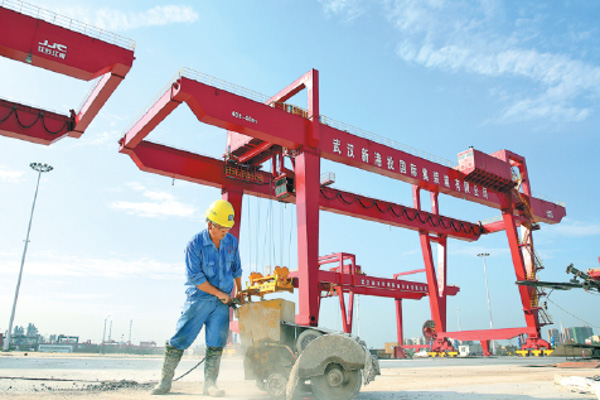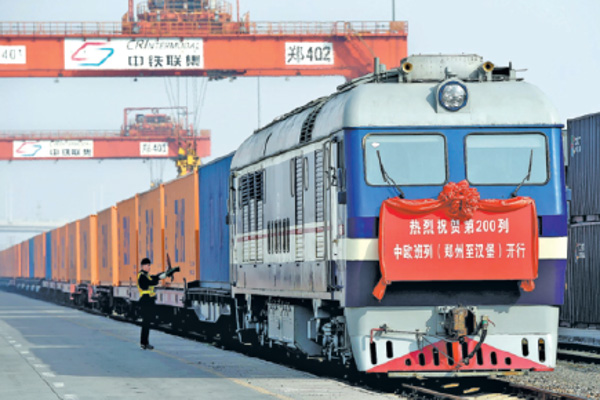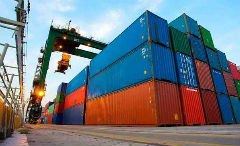Free trade zones set to boost central areas
2017-04-12
China Daily
 A worker operates a machine in Yangluo Port in Wuhan, Hubei province.[Photo/China Daily]
A worker operates a machine in Yangluo Port in Wuhan, Hubei province.[Photo/China Daily]
The two recently launched free trade zones in Hubei and Henan provinces are expected to bring more momentum to a rising Central China.
The China (Hubei) Pilot Free Trade Zone and the China (Henan) Pilot Free Trade Zone were launched on April 1, together with another five in Chongqing municipality and Liaoning, Shaanxi, Sichuan and Zhejiang provinces.
As the two largest provinces in Central China in terms of gross domestic product in 2016, Hubei and Henan provinces are well-positioned to expand opening-up and lead development of the central region, which also includes Anhui, Jiangxi, Hunan and Shanxi provinces.
Henan, with a population of more than 100 million, saw GDP of 4.016 trillion yuan ($581 billion) in 2016, and ranked fifth among all provincial-level regions, while Hubei, with almost half of Henan’s population, recorded 3.23 trillion yuan of GDP in the same period.
Hubei FTZ covers a combined area of 120 square kilometers in the province’s Wuhan, Xiangyang and Yichang, while the Henan FTZ covers a roughly equal land area in Zhengzhou, Kaifeng and Luoyang.
“The Hubei FTZ will greatly benefit enterprises in the province, especially those doing international business”, said Chen Kai, president of the Wuhan-based Medscience Technology Co Ltd, whose core business is import and export of medical materials and equipment.
The company had to import and export the products from Tianjin, Shanghai and Guangzhou ports, while globally-traded commodities will be shipped to and from Wuhan directly in the future.
According to the plans released by the State Council, the Hubei FTZ will be built into a demonstration zone for the transfer of industries from coastal regions to the central region and a base for high-tech industries, in order to play a leading role in the rise of the central provinces and development of the Yangzte River Economic Belt.
The economic belt, announced by the central government in 2014, covers 11 provinces and cities spanning the country’s eastern, central and western regions, with a total area of 2.05 million square kilometers. Its population and GDP account for more than 40 percent of the national total.
 The 200th Zhengzhou-Hamburg cargo train pulls out of Zhengzhou railway station last September.[Photo/China Daily]
The 200th Zhengzhou-Hamburg cargo train pulls out of Zhengzhou railway station last September.[Photo/China Daily]
As a contrast, “Henan FTZ will become the national transport and logistics hub to serve the country’s Belt and Road Initiative,” said Zhang Qiong, director of Henan provincial government’s department of transport.
As the birthplace of Chinese civilization, Henan lies in the central part of China and is often referred to as zhongyuan, which literally means central plain of the midland.
“Henan’s unique geographical location positions it perfectly to take advantage of opportunities opening up along the Belt and Road Initiative economies”, said Danny Alexander, secretary-general of the Asian Infrastructure Investment Bank, during the recently held China (Henan) International Investment and Trade Fair.
Last year, the State Council announced a plan to build the Central Plains Urban Agglomeration, which includes 30 cities in Henan, Anhui, Shanxi and Shandong provinces, with Henan’s Zhengzhou being the core area.
The State Council also launched a program that year to boost development in the central region for the 13th Five-Year Plan (2016-20), saying the rise of the region is of great importance to China’s medium-high economic growth.
Hubei Vice-Governor Tong Daochi said the new FTZs will help facilitate investment and further liberalize trade in commodities.
Both of the FTZs will promote foreign investment, while maintaining their own focus.
Hubei FTZ should explore how to optimize administration after the investment admission phase, while Henan FTZ will attract more international organizations and institutes, headquarters of financial institutions and regional headquarters of enterprises and organizations, according to the official plans.
As one of the four futures exchanges in China, Zhengzhou Commodity Exchange will aim to develop new products for international transactions.
At present, ZCE is available for transactions of 10 agricultural products, including wheat, rice, cotton and rapeseed and five industrial materials, including glass, coal and methanol.
Foreign companies will be gradually permitted to participate in futures exchange with ZCE, according to the FTZ plan.
Henan FTZ will also be built into Central China’s transaction center for intellectual property.
Hubei FTZ should carry out over 200 specific reforms and Henan FTZ will also be responsible for 160 of such tasks, according to the local authorities.
They share some goals to lower the threshold for businesses to set up new companies, cut restrictions on capital flow, and offer more market access to foreign investment.
“To complete the 160 reform tasks, Henan should amend 60 local laws and regulations”, said Jiao Jinmiao, director of the Henan provincial government’s department of commerce and director of the Henan FTZ administration.




